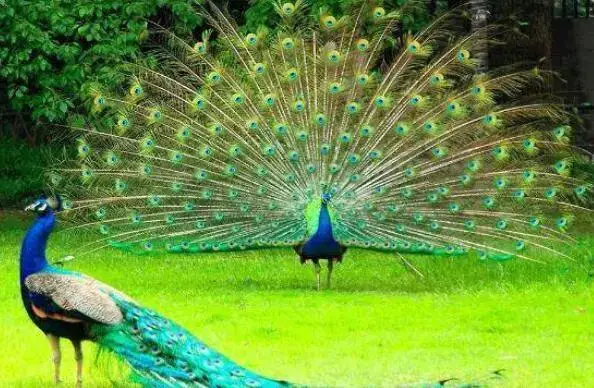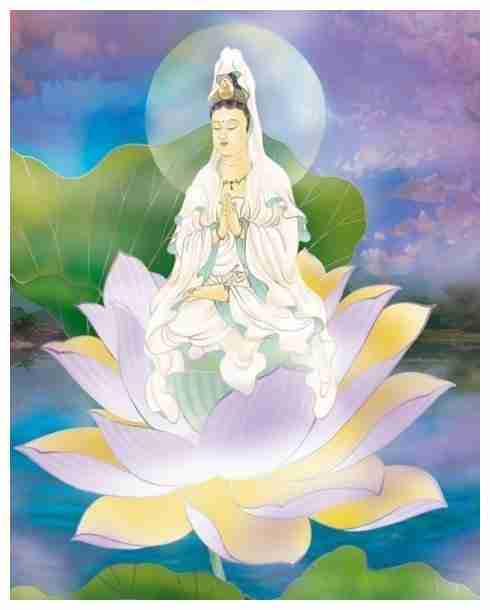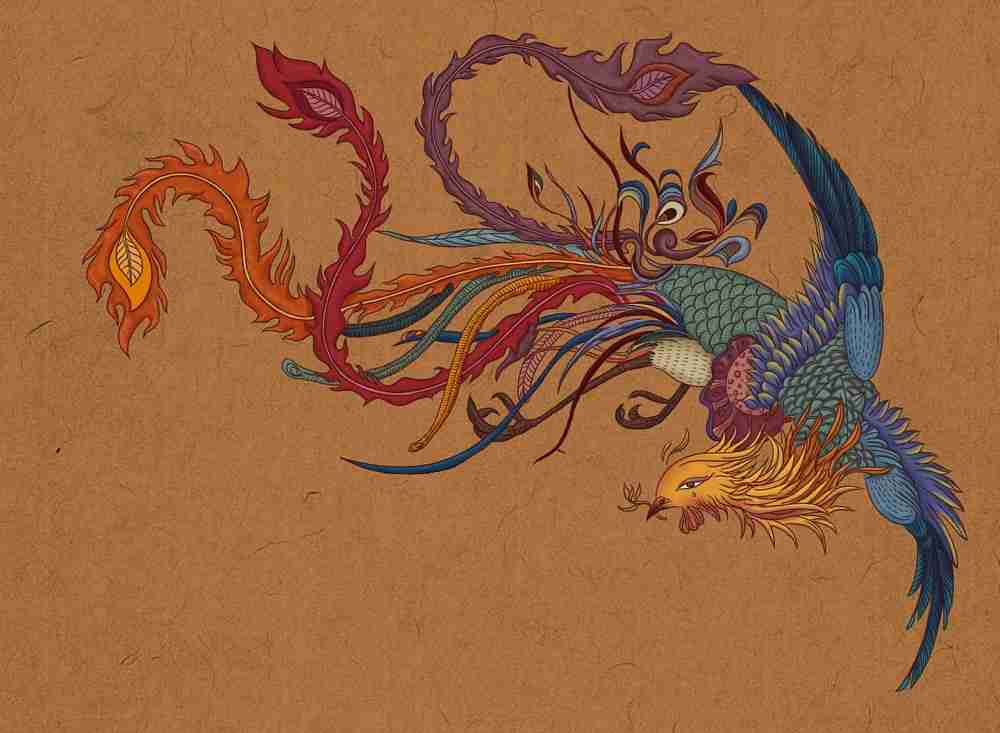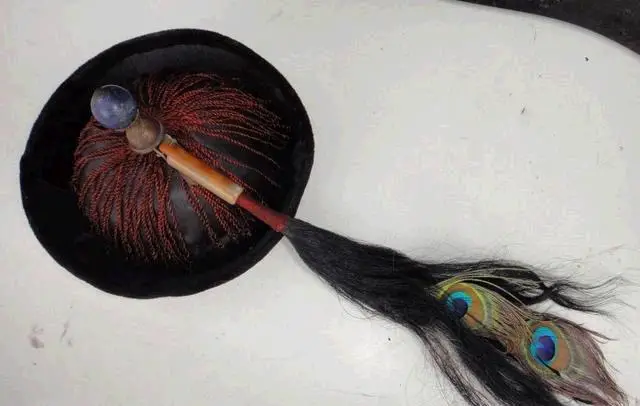The beautiful peacock is a familiar sight in many parts of the world because to its iridescent plumage and vivid feathers. These birds, which are related to pheasants, are revered for their exquisite form and stately bearing. A deeper look at the beautiful peacock birds that can be found in China is what this essay is all about.
What exactly is a peacock bird?

Peacocks are pheasants, a family to which the peacock belongs. The male is significantly larger and more colourfully plumaged than the female, and both sexes are spectacular in size. The Indian peafowl is the most well-known of the three types of peafowl, which also include the green peafowl and the Congo peafowl.
Throughout the Indian subcontinent and into Southeast Asia, you can spot the Indian peafowl. The males of the species are easily recognisable by their iridescent plumage of blue, green, and gold. During courtship rituals, they fan out and flaunt their long, brightly coloured tail. Females have fewer spots of colour and shorter tails.
Peafowl are omnivores, therefore they consume both animal and plant stuff in their diets. They also have a reputation for eating crops, which can lead to tensions with farmers.
Peafowl are notable not just for their extraordinary looks, but also for the unique sounds they make. As part of their courtship rituals, males often emit a loud, high-pitched call in the hopes of attracting females.
There are numerous regions of the world where peafowl hold special cultural significance. The Indian peafowl is the country’s official national bird and stands for India’s elegance, grace, and national pride. According to Chinese folklore, peafowl have the ability to fend off evil spirits because of their divine associations. Peafowl are prized for their aesthetic appeal and are frequently kept as pets in zoos and on private estates throughout the Western world.
where is peacock bird in china ?
There are several areas in China that are home to peafowl, including the endangered Indian peafowl. Nonetheless, the green peafowl (Pavo muticus) is the most significant peafowl species in China because it is the only native peafowl species in China. The green peafowl is a huge, vibrant bird with iridescent green feathers, a blue-green crest, and a round “eye” mark on its tail.
Southeastern China is home to green peafowl, specifically the provinces of Yunnan, Guangxi, and Guizhou, and even further afield in Vietnam and Laos. They like to live in forests close to rivers and streams since that’s where they can obtain food and water.
How Many Peacock Birds Are There in China?

There is just one species of peafowl native to China, and it is the green peafowl (Pavo muticus), also called the “dragon bird” because of its relationship with Chinese mythology. The metallic green sheen of the green peafowl’s feathers, the blue-green of its crest, and the white “eye” mark on its tail make this a striking bird.
Non-native species of peafowl, such as the Indian peafowl (Pavo cristatus) and the white peafowl, have been imported to China alongside the native green peafowl (Pavo muticus albinus). These exotic plants are frequently displayed as decorations in zoos, parks, and private gardens.
The Indian peafowl, or blue peafowl, is a common sight in China and other regions of the world. In comparison to the green peafowl, this bird is both larger and more vibrantly coloured, sporting a metallic blue and green sheen on its feathers, a long, multicoloured tail, and recognisable “eye” markings. Although the Indian peafowl is not indigenous to China, it has been widely introduced throughout the country for its aesthetic value as a garden bird.
The albino peafowl, or white peafowl, is a variation of the green peafowl that does not have any feather pigment. It is bred for its white plumage and ruby eyes, both of which contribute to its high aesthetic value.
The green peafowl is China’s only natural peafowl species, but other species, such as the Indian and white peafowls, have been introduced for conservation and decorative purposes.
If you were to count all the peacocks in China, how many would you count?
It’s hard to put a number on the number of peacock birds in China, but the country is home to two natural kinds of peafowl: the Indian Peafowl and the Green Peafowl. There are an estimated 500 Green Peafowl surviving in the wild, while there are millions of Indian Peafowl in China.
Both species of peafowl are classified as “vulnerable” on the Red List of Endangered Species maintained by the International Union for the Conservation of Nature, which indicates that their numbers are in decline and need protection. The main dangers to these birds are the destruction of their habitats, illegal hunting, and poaching.
The Chinese government has established protected zones for these birds and passed rules to control the hunting and commercial traffic of them. To aid in the preservation and eventual release of these birds back into the wild, the Chinese Peafowl Breeding and Research Centre in Jiangsu province runs a number of research and breeding projects.
However, the true number of peafowl in China is still unclear, and their population is still in steady decline. To guarantee these wonderful birds survive and continue to wow us with their beauty for future generations, it is essential to strengthen conservation efforts and safeguard their habitats.
In Chinese culture, what does the peacock represent?
For ages, the peacock has served as a significant symbol in Chinese culture, carrying a variety of associations and meanings depending on the specific setting. To give just a few examples of the many meanings attributed to peacocks in Chinese thought:
Charm and grace
The peacock is a symbol of grace, dignity, and sophistication in Chinese culture. The peacock is often used as a symbol for beauty and elegance because to the bird’s eye-catching plumage and graceful movements, which have been celebrated in art and literature. The peacock is used to symbolise Daiyu, the heroine of the ancient Chinese literature “Dream of the Red Chamber,” because of her regal status and beauty.
The peacock was a symbol of status and authority in ancient China. The peacock, it is said, was a messenger of the gods whose feathers could drive away evil spirits. Hence, the peacock came to represent safety, and its likeness was frequently featured on the imperial robes and regalia.
Happy Aging and Abundant Life
In Chinese culture, the peacock also represents long life and good fortune. Both the feathers and the flesh of the bird were thought to have curative characteristics in traditional Chinese medicine, and the bird was sometimes employed as a decorative theme in the homes of the wealthy to ensure continued success and happiness. The peacock continues to serve as a symbol of prosperity and joy in some parts of China’s traditional wedding ceremonies.
Metamorphosis and Regeneration
Being a symbol of metamorphosis and rebirth, the peacock plays an important role in Chinese mythology. According to folklore, the bird was once a phoenix that opted to live a modest life in the woods rather than consume the fruit of the Tree of Life. It is believed that the phoenix’s metamorphosis into a peacock represents the bird’s acceptance of its own mortality and its subsequent rebirth. As a parable on how life and death are perpetual cycles, this tale is often presented.
The Concept of Yin and Yang
The yin and yang, two opposing but complimentary elements that are supposed to underpin everything in the universe, are often represented by the peacock in Chinese philosophy. The yin, or feminine, part of nature is represented by the bird’s stunning plumage and delicate motions, while the yang, or male, aspect is reflected in the bird’s loud and boisterous call. There is a common belief that the yin and yang principles are represented in the peacock’s many different facets.
The Practice of Feng Shui
The peacock is thought to usher in good fortune, wealth, and prosperity in the practise of Feng Shui, an ancient Chinese art of placement. The placement of peacock feathers or figurines is thought to increase the flow of positive energy (chi) throughout the home, which is why the bird is frequently depicted in Feng Shui designs.
The peacock has an important role in Chinese mythology.

The peacock is a revered and significant bird in Chinese mythology. The peacock has long been revered in Chinese culture as a symbol of elegance, success, and good fortune due to its spectacular display of colour and detail in its tail. Some of the most significant myths, legends, and metaphorical interpretations of the peacock in Chinese mythology are as follows:
As stunning as a peacock’s eyes,
The peacock’s most striking feature is the appearance of hundreds of eyespots all over its tail feathers. These eye-like markings on the bird are symbolic of its all-seeing and wise nature in Chinese mythology. Because of its intimidating display, the peacock is able to protect itself from potential threats and ward off any potential attackers.
Both the peacock and the phoenix are emblems of good fortune, beauty, and prosperity in Chinese mythology. The phoenix represents the sun, while the peacock symbolises the moon; as such, the two birds are often viewed as polar opposites. All three together symbolise the interplay between day and night, good and evil, yin and yang, and the cyclical nature of life, death, and rebirth.
Peacock’s Tears:
It is also well-known in Chinese folklore that the tears of a peacock have curative properties. A young woman was nearly dead after being bitten by a poisonous snake, as told in this myth. On the other hand, a kind peacock witnessed the woman’s plight and wiped her tears from its eyes into her wounds, restoring her health. Peacocks are frequently used as symbols of healing and compassion in art and literature because of this historical association between the bird’s tears and these concepts.
In “The Peacock and the Dragon,” the contrasting
The dragon is a potent emblem of might and good fortune in Chinese mythology. In contrast, the peacock is a sign of safety, devotion, and grace. The peacock has been depicted either protecting the dragon’s treasure or serving as the dragon’s faithful companion. In this tale, the peacock’s traditional meanings as a symbol of loyalty and safety are reflected.
The Guan Yin and the Peacock
As was noted before, in Chinese mythology the peacock is also linked to Guan Yin, the goddess of compassion. As a symbol of her all-seeing gaze and boundless compassion, Guan Yin is frequently shown riding a peacock. The lotus flower, held in the peacock’s beak in certain portrayals, stands for spiritual awakening, enlightenment, and progress.
The peacock is a symbol of Chinese culture and civilisation, appearing frequently in Chinese art and literature. This is due to the fact that the bird’s beautiful feathers have been used to represent wealth and success for a very long time. The peacock is typically shown in traditional Chinese paintings as being in a garden or other natural setting, with flowers and other symbols of prosperity and abundance surrounding it.
In Feng Shui, what does the peacock represent?
The peacock is a potent emblem of safety, prosperity, and good fortune in Feng Shui, the ancient Chinese technique of spatial arrangement for maximum energy flow and harmony. Some of the most important ways in which the peacock is employed in Feng Shui are as follows: Protection: The peacock is viewed as a symbol of protection in Feng Shui and is frequently employed to ward off negative energy and evil spirits. It is thought that the gorgeous and colourful feathers of the bird create a protective energy field around the home or business, warding off evil spirits while welcoming in peace and prosperity.
In Feng Shui, the peacock is also a symbol of wealth and plenty. The brilliant colours and intricate patterns of a bird’s feathers are symbolic of the boundless possibilities and gifts available in the cosmos. Inviting prosperity and success into one’s life through the use of peacock feathers or other peacock-themed decor.
The peacock is revered in Feng Shui not only for its symbolic meaning and its association with prosperity and safety, but also for its stunning beauty and refined air. Its graceful flight and vibrant plumage are thought to infuse the surrounding space with a sense of peace and harmony, ideal for fostering innovative thought and relieving stress.
For the best Feng Shui results, it is essential to strategically arrange any peacock-themed accessories. Place a peacock feather in the wealth sector of your home or business to bring in more money, and put a statue of a peacock by the front door to ward off evil spirits and invite good fortune.
Color is an essential part of Feng Shui’s approach to establishing a conducive and balanced ambiance. Blue, green, and gold, the peacock’s signature hues, are thought to encourage healing, growth, and change and hence are ideally suited for use in therapeutic, expansive, or regenerative zones at home or at the workplace.
Is there a Peacock in the Chinese Phoenix?
The Fenghuang, or Chinese phoenix, is not a type of peacock. Although these birds share a significant place in Chinese folklore, they look and represent different things.
The phoenix is a legendary bird in Chinese mythology that is said to represent rebirth, elegance, and good fortune. A rooster’s head, a parrot’s beak, bat wings, and a peacock’s tail are some of the animal parts that have been used to depict this monster. Although it shares some similarities with the peacock, the Chinese phoenix is not the same bird.
It is thought that the Fenghuang symbolises the union of Yin and Yang in Chinese mythology, and as such is frequently linked to the emperor and empress. Each of its components is associated with one of the Five Elements, further strengthening its connection to that philosophical framework. Feathers are metal, beak is wood, tongue is fire, feet are earth, and voice is water, according to the legend.
Yet, the peacock is a real bird that may be seen not just in South Asia but also in some regions of China. The colourful, iridescent feathers on its tail mimic eyeballs, and are only one example of the bird’s unique plumage. The peacock is a symbol of grace, generosity, and good fortune in Chinese culture.
What sets a phoenix apart from a peacock?

The phoenix is a legendary bird, while the peacock is a real bird. The phoenix is a symbol of virtuous grace and wealth, while the peacock represents attractiveness, generosity, and good fortune. Usually, the phoenix will have fiery feathers, whereas the peacock will have iridescent ones, especially on its tail. Although these birds play significant symbolic roles in many different cultures, their look, symbolism, and cultural significance are quite different from one another.
Peacock and Li Yuan
In the Northern Zhou dynasty, the elder sister of Emperor Wu of Zhou gave birth to a baby girl, who would later become Empress Dou. Dou’s father, Dou Yi, often said, “This daughter is beautiful and knowledgeable. She cannot marry just anyone.” He then painted two peacocks on a folding screen and had each suitor shoot two arrows. He secretly decided to betroth his daughter to whoever could hit the peacock’s eye with both arrows. Dozens of suitors tried but failed to meet the requirement until Tang Gaozu Li Yuan shot two arrows and hit both peacock eyes. Dou was then married to Li Yuan, who later became emperor, and she became the empress.
Peacock in the Ming And Qing Dynasty
The peacock is known for its beauty among birds. It has a graceful body, red beak, black eyes, and a slender, broad chest. The male peacock’s tail is three feet long, with a magnificent and brilliant display of colors that shine and glitter like copper coins. The circular patterns on its back and tail feathers are called “eye circles,” which are adorned with shimmering gold and emerald colors, and are beautiful to behold. Because of its beauty and virtue, the peacock became a symbol of rank and power in the official robes of civil servants during the Ming and Qing dynasties. In the Ming dynasty, the third-ranked civil servant had a peacock symbol on their robes, while during the Qing dynasty, both the second and third-ranked civil servants had peacock symbols. A painting with a coral vase and peacock feather design represents good fortune and wishes for promotion and success in a government position.
In the Qing Dynasty, official hats were vastly different from those of previous dynasties. Military and political personnel above the rank of the common soldier and police officer wore small, brimmed hats resembling a bamboo hats. The hats varied between warm and cool styles depending on the season and were adorned with different colored and textured tassels based on the wearer’s rank. A bundle of peacock feathers was also attached to the back of the hat. These feathers were known as “flower feathers” and were distinguished by the number of “eyes” or circular patterns on the feathers, with more eyes indicating a higher rank. Only princes or high-ranking officials with outstanding achievements were awarded the privilege of wearing flower feathers with multiple eyes.

Traditional Chinese Dance of the Peacock
Throughout China’s history, the peacock dance has been a staple of cultural celebrations. It’s usually done by a single dancer decked out in an outfit meant to evoke a peacock’s feathers. The fan movements mimic the peacock’s spreading tail feathers, and the resulting dance is both graceful and ornate.
The peacock dance has deep roots in Chinese tradition and is regularly showcased at major festivals like the Lunar New Year holiday. It can be a single act or a part of a broader dance performance.
The dance is renowned for its complex yet elegant movements, which call for a considerable deal of training and practise to perfect. The dancer needs incredible balance and control to move their fan in a way that looks like the fluttering of a peacock’s tail.
The Chinese peacock dance is a cultural relic that has been passed down from generation to generation in China. Traditional Chinese dance is still highly valued outside of China by those who recognise its aesthetic value.
To sum up, the peacock is a key emblem in Chinese culture since it stands for elegance, majesty, and long life. Because of its sacred significance, the theme appears frequently in Chinese mythology, art, and literature. The significance of the peacock in Chinese culture is highlighted by the graceful and majestic Chinese Peacock Dance.
phoenix VS Peacock
In Chinese culture, both the phoenix and the peacock are symbolic birds that represent beauty, grace, and good fortune.
The phoenix, also known as the Fenghuang, is a mythical bird that symbolizes resurrection and rebirth. It is often depicted with vibrant colors such as red, yellow, and green, and is associated with the sun, fire, and the south. The phoenix is considered a symbol of prosperity and good luck, and is often used in weddings, celebrations, and other auspicious occasions.
The peacock, on the other hand, is a real bird that is known for its striking beauty and colorful feathers. It is often associated with pride, dignity, and extravagance, and is a symbol of beauty and good fortune in Chinese culture. The peacock’s feathers, with their mesmerizing “eyes,” are considered a symbol of protection and warding off evil.
While both birds represent positive qualities and are highly regarded in Chinese culture, the phoenix is more closely associated with mythical qualities such as resurrection and immortality, while the peacock is more closely associated with earthly beauty and elegance.